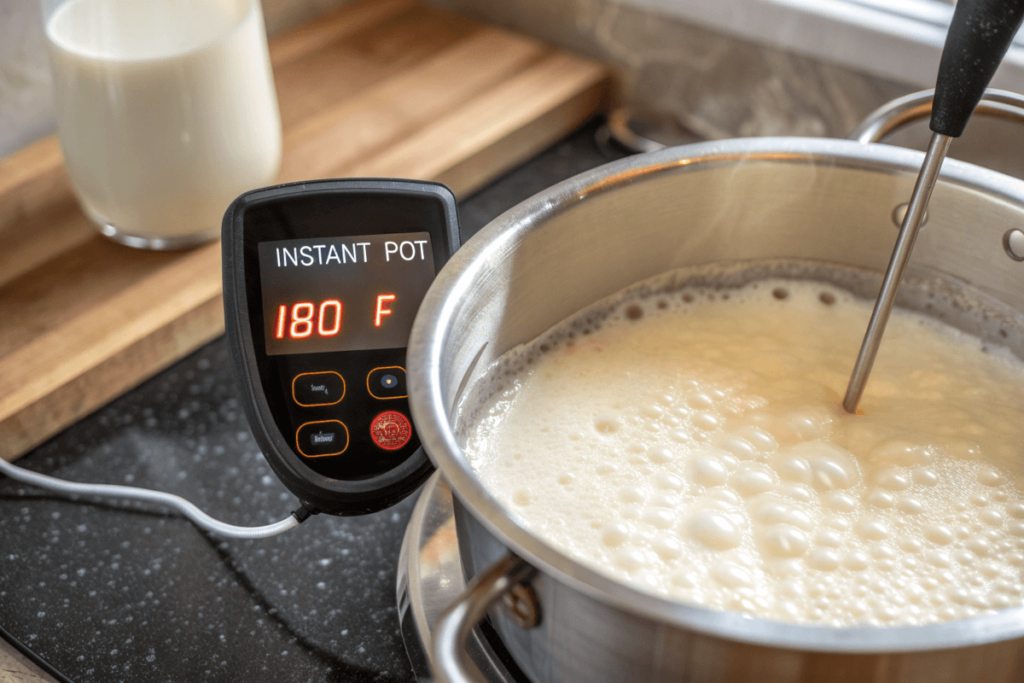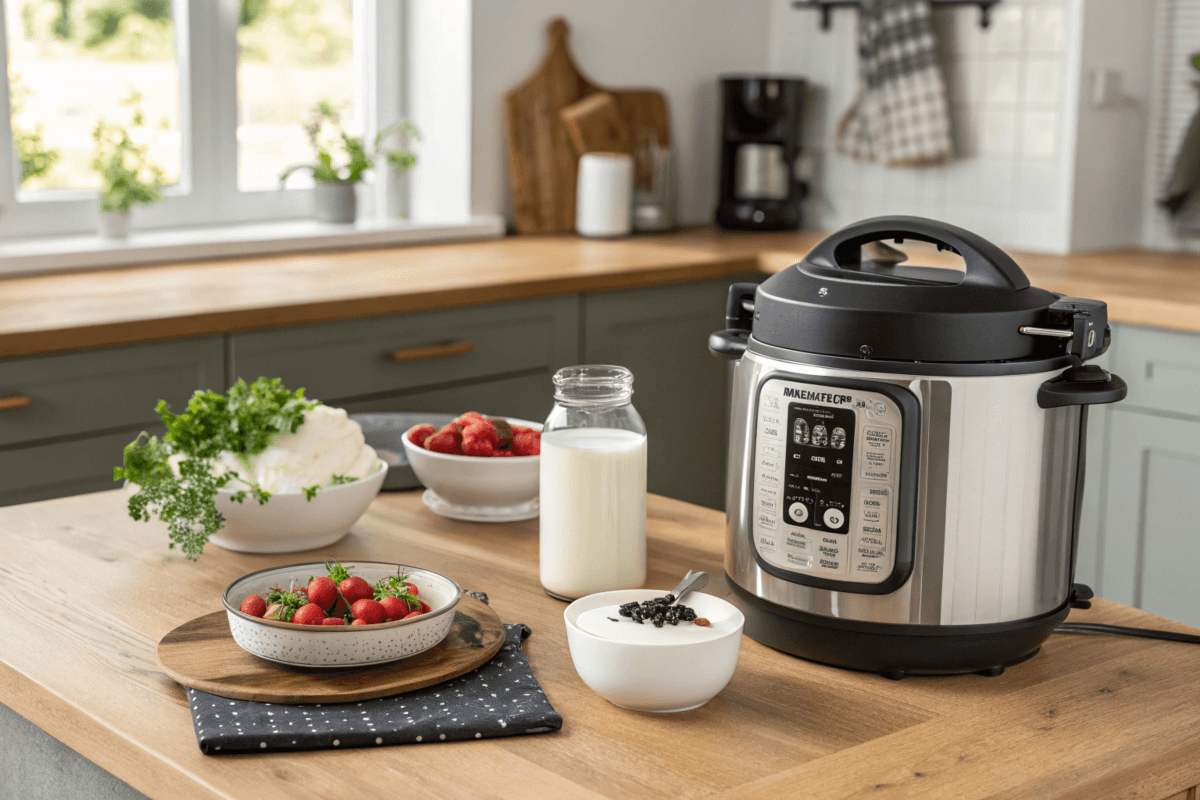Making yogurt at home has gained massive popularity, and the Instant Pot is often at the heart of the action. But why do people boil milk in an Instant Pot for yogurt? This article dives into the science, methods, and benefits of boiling milk, revealing how this step ensures silky, tangy yogurt every time. Whether you’re a novice or a seasoned yogurt maker, you’ll uncover insights into why this process is essential and how to get the best results. Let’s get started!
The Science Behind Boiling Milk for Yogurt
The Importance of Heating Milk
One of the first steps in yogurt making is heating the milk, typically to around 180°F (82°C). But why is this step non-negotiable? The key lies in pasteurization. Heating milk to this temperature kills unwanted bacteria that could interfere with the fermentation process. These rogue microbes can sabotage the growth of the live culture—the good bacteria responsible for transforming milk into yogurt.
Moreover, heating milk also denatures its proteins, particularly casein. This change in protein structure is what creates yogurt’s signature creamy texture. Without this step, you’d end up with a runny, uneven result that lacks the thick, luscious consistency most people love.
Impact on Yogurt Texture and Taste
Boiling milk doesn’t just fend off bad bacteria—it’s a game-changer for taste and texture. By altering the milk proteins, the process ensures they form a stable structure during fermentation. The result? Yogurt that’s velvety and smooth, not watery or grainy.
But what happens if you skip boiling? While you might still get yogurt, it won’t be as firm or creamy. Plus, any leftover bacteria in unheated milk could lead to off-flavors or spoilage. It’s a risk most yogurt enthusiasts aren’t willing to take!
Why Use an Instant Pot for Yogurt Making?
Convenience of the Instant Pot Yogurt Function
The Instant Pot has revolutionized homemade yogurt by simplifying the process. With the yogurt function, this device handles critical steps, like heating milk to the ideal temperature for pasteurization and maintaining a stable environment for fermentation. Unlike traditional methods requiring constant monitoring, the Instant Pot automates most of the hard work.
This automation ensures consistent results, even for beginners. The device’s precise temperature control prevents overheating or underheating, which are common pitfalls when making yogurt manually. For many, the question of why do people boil milk in an Instant Pot for yogurt boils down to convenience. The appliance provides a one-pot solution, reducing cleanup while enhancing efficiency.
For step-by-step instructions on using the yogurt setting effectively, you can explore this guide.
Comparison with Traditional Methods
Traditional yogurt-making often involves stovetop cooking, thermometers, and separate containers for incubation. These methods require careful attention to ensure the milk doesn’t scorch or cool too quickly. In contrast, the Instant Pot eliminates these hassles. By consolidating the process into one device, it saves time and effort while producing reliably creamy yogurt.
Whether you’re transitioning from a stovetop or experimenting with yogurt for the first time, the Instant Pot offers unparalleled ease and consistency. This reliability is why so many people turn to it for making homemade yogurt.
Step-by-Step Guide to Making Yogurt in an Instant Pot
Boiling the Milk
The first step in using your Instant Pot for yogurt is boiling the milk. Use the Boil setting to heat milk to approximately 180°F. This step is crucial for killing any bacteria that might interfere with the fermentation process. Once the Instant Pot signals that the cycle is complete, check the milk’s temperature with a thermometer to ensure it’s within the target range.
If you’re wondering why do people boil milk in an Instant Pot for yogurt, this is the reason: it ensures a clean slate for your starter culture, paving the way for smooth and tangy yogurt.
Cooling and Adding Starter Culture
After boiling, allow the milk to cool to around 110°F. This temperature is ideal for the live culture to thrive without being destroyed by heat. Transfer a small portion of the milk to a bowl, mix it with your yogurt starter, and then combine it with the rest of the milk in the Instant Pot.
The starter contains beneficial bacteria that ferment the milk, transforming it into yogurt over time.
The Incubation Process
Once the starter is mixed, set the Instant Pot to the Yogurt function. The device will maintain a stable temperature (typically around 110°F) during the incubation period, which lasts 8–12 hours depending on your desired tanginess. Longer incubation times produce tangier yogurt.
After incubation, transfer the yogurt to a container and refrigerate it to set further. This step enhances the texture and makes it ready to enjoy!

For tips on getting the perfect consistency, check out this recipe .
Common Issues When Making Yogurt in an Instant Pot
Curdling or Separation
One common frustration in yogurt-making is curdling or the separation of whey from the solid yogurt. This often happens when the milk wasn’t boiled to the proper temperature or wasn’t cooled adequately before adding the starter culture. To avoid this, always use a thermometer to ensure accurate temperature control. Another factor could be the quality of your starter culture—opt for fresh, live cultures for the best results.
If you’ve ever wondered, Why do people boil milk in an Instant Pot for yogurt, the answer lies in avoiding these texture issues. Boiling helps stabilize the proteins, reducing the risk of curdling.
Weak or No Fermentation
Another issue is weak or no fermentation, which usually results in a runny or flavorless yogurt. This can happen if the incubation temperature wasn’t consistent. The Instant Pot excels here by maintaining an even temperature, but it’s essential to double-check the settings. Using ultra-pasteurized milk or expired starter cultures can also hinder proper fermentation.
If your yogurt turns out watery, consider draining it through cheesecloth to create a thicker, Greek-style consistency. You can also experiment with extending the incubation time to improve tanginess.
Benefits of Homemade Yogurt
Nutritional Advantages
Homemade yogurt is packed with health benefits. Rich in probiotics, it supports gut health and boosts immunity. Unlike store-bought options, which can be loaded with sugar and preservatives, homemade yogurt offers a wholesome, additive-free alternative.
By understanding why people boil milk in an Instant Pot for yogurt, you’re ensuring a cleaner, healthier product. Boiling removes unwanted bacteria, leaving room for only the beneficial cultures to thrive.
Cost-Effectiveness and Customization
Another advantage of homemade yogurt is its cost-effectiveness. A single gallon of milk can yield several servings of yogurt, saving you money over time. Plus, you can customize the flavor, texture, and sweetness to suit your preferences. Whether you enjoy plain, tangy yogurt or sweetened variations with fruit, homemade options give you total control.
For more ideas on homemade recipes, explore recipe or check out the site for other delicious options.
Variations and Additions to Homemade Yogurt
Sweet and Savory Additions
Homemade yogurt is like a blank canvas for creativity. From fresh fruits like berries and mangoes to natural sweeteners like honey or maple syrup, the possibilities for sweet variations are endless. Add a dash of vanilla extract or a sprinkle of cinnamon for a comforting twist.
For those with savory preferences, mix in herbs like dill or mint, and pair the yogurt with vegetables for a refreshing side dish or dip. Customizing yogurt at home allows you to explore flavors not typically available in store-bought versions, making it both unique and delicious.
If you’re wondering why do people boil milk in an Instant Pot for yogurt, part of the reason is to create a versatile base that blends well with these diverse additions.

Using Alternative Milk Types
For those who can’t consume dairy or prefer plant-based diets, alternative milk options like almond, soy, or coconut milk can be used to make yogurt. However, these milk types may require additional steps, such as adding thickeners like agar-agar or tapioca starch to achieve the desired consistency.
Boiling is still essential for many plant-based milks to ensure the elimination of bacteria and improve protein stability. The Instant Pot simplifies this process, making it easy to experiment with various milk types while ensuring high-quality results.
FAQs About Boiling Milk for Yogurt
Why Must Milk Be Boiled Before Making Yogurt?
Boiling milk is crucial for preparing it to accept the yogurt culture. It eliminates harmful bacteria that could compete with the good bacteria in the starter culture. This step also improves the yogurt’s texture by denaturing the milk proteins, allowing them to form a firmer structure during fermentation.
What Happens If Milk Isn’t Boiled?
Skipping the boiling step often leads to inconsistent results. The yogurt might turn out runny, grainy, or even spoil due to unwanted bacterial interference. That’s why the question, why do people boil milk in an Instant Pot for yogurt, has such a clear answer—it ensures success.
Can I Use Ultra-Filtered Milk Without Boiling?
Yes, ultra-filtered or ultra-pasteurized milk doesn’t always require boiling because it has already undergone heat treatment. However, some prefer to heat it slightly to enhance its performance during fermentation.
How Does Boiling Affect Yogurt’s Nutritional Value?
While boiling may reduce some heat-sensitive vitamins, the nutritional loss is minimal. The fermentation process compensates for this by introducing probiotics, making yogurt a highly nutritious food.
These sections explore creative ways to enjoy homemade yogurt and address common questions about boiling milk in the yogurt-making process. They continue to emphasize the importance of this step for achieving the best results.
Expert Tips for Perfect Yogurt Every Time
Selecting the Right Milk and Starter Culture
Achieving the perfect yogurt starts with selecting high-quality ingredients. Whole milk is often the best choice for rich, creamy yogurt, but low-fat or skim milk can also work well if you prefer a lighter texture. For plant-based yogurt, ensure the milk alternative has no added oils or stabilizers, which can affect fermentation.
When it comes to starter culture, opt for plain yogurt with live, active cultures. Look for a label that specifies active bacteria like Lactobacillus bulgaricus or Streptococcus thermophilus. Freshness is key—older starters may yield inconsistent results.
Understanding why people boil milk in an Instant Pot for yogurt helps emphasize the importance of starting with clean, well-prepared ingredients to create the perfect foundation for fermentation.
Using a Thermometer for Accuracy
Precision is essential in yogurt making. A simple kitchen thermometer ensures your milk is heated to the correct boiling temperature (around 180°F) and cooled to the optimal range (110°F) before adding the starter. Skipping these steps can lead to runny or failed yogurt.
The Instant Pot simplifies the process, but double-checking with a thermometer adds a layer of assurance. This attention to detail ensures every batch turns out smooth and delicious.
Advanced Techniques: No-Boil Yogurt and Beyond
Making Yogurt Without Boiling Milk
For those using ultra-pasteurized or ultra-filtered milk, the boiling step can sometimes be skipped. These milk types are preheated during processing, which eliminates bacteria and denatures proteins, mimicking the boiling process. This method appeals to people seeking a quicker way to make yogurt.
However, even with no-boil methods, temperature control remains critical. The Instant Pot’s yogurt setting provides the stable environment needed for fermentation, ensuring your yogurt turns out perfectly.
Experimenting with Probiotic Strains
For adventurous yogurt makers, experimenting with different probiotic strains can lead to unique flavors and added health benefits. Combining cultures like Bifidobacterium with traditional strains can create yogurt with enhanced digestive and immune-supporting properties.
Trying alternative fermentation times or blending different milk types adds even more variety to your creations. By understanding why do people boil milk in an Instant Pot for yogurt, you gain insight into how to adapt processes while maintaining quality.
These sections wrap up the article by offering expert insights and advanced techniques for yogurt making, catering to both beginners and seasoned enthusiasts. The consistent emphasis on boiling milk ties back to the importance of preparation in achieving flawless results.


2 thoughts on “Why do people boil milk in an Instant Pot for yogurt?”